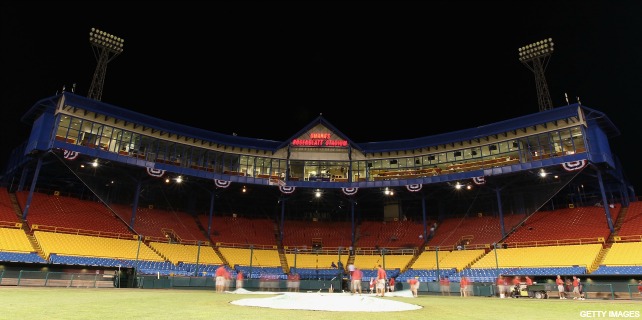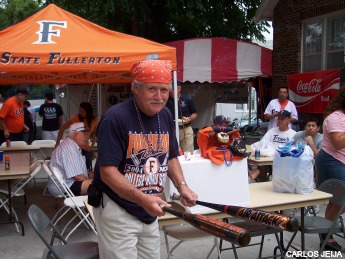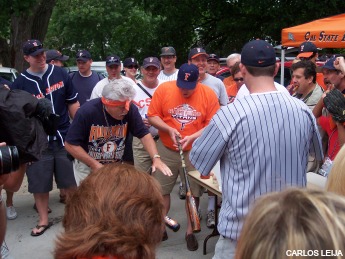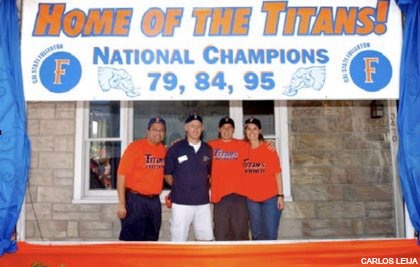Carlos Leija isn't attending this year's College World Series, and it's killing him. He's followed Cal-State Fullerton to Omaha every time since 2001, including the Titans' 2004 run to the title -- what adds up to five times in a nine-year span.
Leija hasn't been to Omaha since 2009, the last time Fullerton made it to the NCAA's college baseball championship. It's work obligations, he insists, that kept him from joining friends and family traveling to cheer on the Titans.
But he also knows that, if he went, he'd find a much different College World Series than the one he left six years ago.
"It's so different," Leija says. "What went on on 13th Street, that's a little piece of Americana that’s gone."
If you've only seen the College World Series on television, you probably can't even tell the difference. Maybe you'll notice the lack of red, yellow and blue outfield bleachers, or you'll realize that the Henry Doorly Zoo no longer serves as the back drop during home runs and aerial shots of the stadium.
If you've been to the games in person, though, the difference is unmistakable: Yes, the College World Series remains an exciting 10-day party at which college baseball teams descend upon Nebraska, and locals embrace them with open arms.
But when you get outside the stadium, the experience has altogether changed.
TD Ameritrade Park, where the CWS has been played since 2011, is nestled in a vibrant part of Omaha's downtown area. By all measures, it's a great location -- unless you compare it to its predecessor, Rosenblatt Stadium.
Originally the Omaha Municipal Stadium, Johnny Rosenblatt Stadium -- named for the mayor who first struck a deal to host the CWS -- was built in 1947. In 1950, it became the CWS host and never relinquished its hold. In a state where football is a way of life, the College World Series serves as an annual holiday season.

Rosenblatt understandably had its legacy intertwined with the CWS. Over the years, the stadium distinguished itself from other venues across the country by unique location and community feel: Rosenblatt was a giant stadium built in a largely residential neighborhood. It's surrounded on three sides by rows of houses. On the fourth side is the Henry Doorly Zoo.
As the CWS and the stadium both grew -- expansions and upgrades to the venue helped to extend its lifespan -- the neighborhood around it remained largely unchanged. A small cluster of local businesses thrived off the annual CWS traffic. Some of the homes even started to rent out for CWS visitors.
That was how Cal-State Fullerton's "Titan House" came to be. Back in 2001, Leija was working for Fullerton's alumni relations. He went to Omaha for the College World Series and couldn't believe the environment: Not just the sport itself, but the way locals adopted for Fullerton and rooted for the school.
Leija saw an opportunity. He says Fullerton was going through an entrepreneurial phase, and it was a great time for big ideas and innovative thinking at the university.
"I decided, OK, when we come back, we'll be a little more prepared," Leija says.
Fullerton returned in 2003, and when the Titans did, they had a home base for fan activity. Leija found a house to rent out across the street from the stadium, and it cost just $3,000 for the entire series. The school rented it out and draped it in Titans banners -- partly out of necessity.
"The house was in complete disrepair," Leija says. "It wasn't a very -- it needed help, let's just say that."

At the end of that year, Leija went around the neighborhood and filled a Rolodex with houses that were available for rent. In 2004, Fullerton returned to the CWS once again. Leija found a beautiful home on 13th Street to serve as the hub for Fullerton activity.
Quickly, the "Titan House" became much more than just a practical gathering place. It was a CWS institution: Its flags and banners flew on the busiest stretch of street in the city, and its front door was always open to passersby. Aerial shots of the stadium broadcast images of the Titan House's rooftop banners to a national audience.
"We were in communication when the team bus, so we knew when the team bus was coming," Leija says. "Coming up 13th Street, we'd get all our fans from the backyard up to the front.
"When we won it in 2004, [Fullerton catcher] Kurt Suzuki said, 'Carlos, you have no idea how much it meant to me, and the feeling I got, when I saw my parents outside of the Titan House.' We didn't know it, but the entire team was on the right side of the bus watching our fans cheer them on."
Visitors to the Titan House even included casual fans and Omaha residents who just wanted to see what all the fuss was about. The Titan House was a family-friendly operation that kept a grill hot and welcomed visitors for a bite to each.
The Fullerton baseball team would even come over to eat a meal every now and then. During this stretch of frequent CWS appearances, Omaha became a second home for Fullerton baseball.

"We come out there [and people would think], 'Well who’s that little school," Leija says, while also noting that Fullerton's enrollment is 37,000. "There's a bit of nostalgia [with that neighborhood] -- unless you've seen, unless you saw Rosenblatt, it's hard to understand. We did fit in there really well."
Omaha's bond with the College World Series is such that the city and the NCAA signed a 25-year contract in 2010, ensuring the series would stay in Omaha until at least 2035. But with that agreement came a controversial decision: Omaha would build a new downtown stadium, which offered higher revenues along with increased parking and proximity to hotels. In 2011, the CWS moved downtown.
Now, Rosenblatt is gone. Its real estate was sold to the zoo, and the structure was demolished. Only the infield remains as a marker for the historic venue. For Leija, it's a disappointing loss. With the loss of Rosenblatt went the community that went with it -- including the Titan House.
Speaking just days before the CWS was slated to begin, Leija asks whether Starsky's Bar and Grill, a local dive woven into the community around Rosenblatt, is still there. His brother-in-law wants to know if he can make a trip back.
Starsky's is still in operation -- but it has changed locations. With the loss of an annual influx of traffic, the bar needed a change of scenery.
In the end, Fullerton's 2015 run was not as fortunate as it was in 2004. After going up early in their first two games, the Titans blew leads and lost both games in the double-elimination tournament.
The first loss was particularly crushing: After leading 3-0 Sunday against Vanderbilt, a rain delay forced the game to pause until Monday. The Titans' good fortune didn't carry over into the next day: Vandy won 4-3 thanks to a stunning three-run ninth.
Leija is sure that rain delay disrupted the Titans and turned a likely win into a loss. But that's life in Omaha.
Says Leija: "Baseball gods giveth and taketh."





